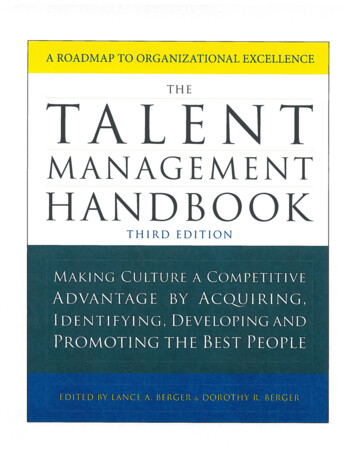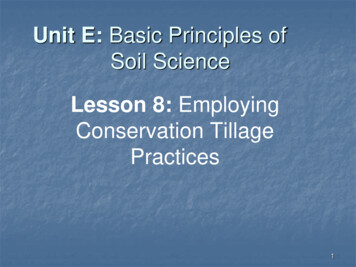
Transcription
Basic ManagementPrinciplesAuthor:Jack E. Fincham, PhD, RPhDean & ProfessorUniversity of KansasSchool of Pharmacy
Learning Objectives Understand basic management principlesapplying to individuals, small and largeorganizations Grasp the basics of management functions Appreciate the ideal characteristics of a goodmanager See the importance of knowledge of self whenviewing management skills Recognize professional skills required ofmanagers
Learning Objectives Appreciate the impact that unresolved issuescan have on management skills Be knowledgeable of the varying availableself-development methods Understand strategic planning and its use Understand how project management tenetscan be applied to initiation of new productsand services Know how to implement a project andevaluate the process
Learning Objectives Understand varying problems from a riskmanagement standpoint that can impact apharmacist in a management position Appreciate varying problem solving techniquesand processes; and their applications topharmacy management situations Appreciate the origins, key elements andapplicability of continuous quality improvement(CQI)
Learning Objectives See how the P-D-C-A segments of the CQIprocess can enable a manager to impactproblems and opportunities in pharmacy Know how change impacts varying aspects ofa pharmacy View motivation as a crucial skill for amanager in pharmacy settings Appreciate the need to obtain involvementand commitment from others to set in placemechanisms to affect change
Key Management Components SelfControllable surroundingsUncontrollable surroundingsThe external environment
Basic Management PrinciplesPart 1 – Basic Management Functions
Management Activities Satisfy varying entitiesDealing with emergenciesPurchasingRecruitmentAccounting
Management Activities TrainingPlanningNegotiatingSalesDealing with regulatory officials
Basic Management Actions Identify what is needed or has to bedone Organize resources Monitor performance and taskcompletion Plan ahead for future requirements Deal with any problems that arise
Functions of ManagementActions Target settingProblem solvingLeadershipTeam buildingDealing with emergencies
Management Functions ControllingDirectingOrganizingPlanningStaffing
Management Functions Controlling– Establishing standards based uponobjectives– Measuring and reporting performance– Comparing the two– Taking corrective/preventive action– Directing
Management Functions Directing– Motivation– Communication– Performance appraisal– Discipline– Conflict resolution
Management Functions Organizing– Division of labor– Delegation of authority– Departmentalization– Span of control– Coordination
Management Functions Planning– Vision– Mission– Objectives– Goals
Management Functions Staffing– Recruiting– Selecting– Hiring– Training– Retraining
Basic Management PrinciplesPart 2 – Characteristics of a GoodManager
Importance of Knowledge ofSelf Identity, who are we and what do weaspire to become? New information, what else do we needto know? Relationships, who else needs to behere to work with us?
Professional Skills Required ofManagers Intellectual skillsTechnical skillsEthical skillsInteractive skillsEmotional skills
Professional Skills Required ofManagers Intellectual skills– Logical thinking– Problem solving
Professional Skills Required ofManagers Technical skills– Motor performance at various tasks
Professional Skills Required ofManagers Ethical skills– Define right from wrong
Professional Skills Required ofManagers Interactive skills– Communicate intelligently and create anatmosphere that facilitates communication
Professional Skills Required ofManagers Emotional skills– Ability to identify and handle one’s feelings
Most Threatening UnresolvedIssues Poor communicationDeveloping peopleEmpowermentLack of alignmentEntitlement
Most Threatening UnresolvedIssues Balancing work and personal lifeConfronting poor performanceCoaching senior managementCross-functional strifeFascination with programs
Seeing Decisions Through Identify objectivesAnalyze relevant factorsConsider all alternativesSelect the best optionImplement the decisionEvaluate the results
Management Style andLeadership OrganizationSituationPersonal valuesPersonalityChance
Self-Development Methods ObservationReflectionGuided readingsVisits / attachments
Self-Development Methods Seeking feedback Seeking challenges– Presentations– Chairing meetings Prepared packages
Basic Management PrinciplesPart 3 – Strategic Planning
Strategic Planning“Strategic planning must complementstrategic thinking and acting.”
Strategic Planning – SWOTAnalysis StrengthsWeaknessesOpportunitiesThreats
Strategic Planning Where are we going?– Mission How do we get there?– Strategy
Strategic Planning What is our blueprint for action?– Budgets How do we know if we are on track?– Control
Strategic Planning Mission statementMandates statementS-W-O-TStrategic issues (goals – ideal future)StrategiesVision of success
Strategic Planning Strategies– Practical alternatives Dreams, Visions Barriers Major proposals Major activities Specific steps
Strategic Planning Strategies– Staffing plans– Financial plans– Timelines / responsible persons
Vision of Success MissionBasic philosophy and core valuesGoals, if establishedBasic strategies
Vision of Success Performance criteria Important decision rules Ethical standards expected of allemployees
Environment StabilityComplexityMarket diversityHostilityCompetition
Planning Should Lead toProgramming“Real strategists get their hands dirtydigging for ideas, and real strategiesare built from the occasional nuggetsthey uncover.”
Involve Others Throughout theOrganization The cascade of information should notjust flow downward Important that it not be a top down onlyprocess
Involve Others Throughout theOrganization Arm all workers with strategicinformation allowing to do their jobbetter Provide universal ownership forproblems and opportunities
Basic ManagementPrinciplesPart 4 – Project Management
Failure of Organizations inDeveloping Projects Lack of focus and attention Inability to cope with different projectcharacteristics Feelings of being used/exploited Lack of project experience
Failure of Organizations inProjects Inability to cope with different projectcharacteristics– New relations with other departments– Tighter time and budget pressure– Use of different methods and tools– Different reporting structure tomanagement
Modern Project ManagementProcess Develop ideas and proposals forprojects Project approval Project kick-off and start Project monitoring, reporting, andmanagement Project end or termination
Project Management 10Commandments Concentrate on interfacingOrganize the project teamPlan strategically and technicallyRemember Murphy’s LawIdentify project stakeholders
Project Management 10Commandments Be prepared to manage conflictExpect the unexpectedListen to intuitionApply behavioral skillsFollow up to take corrective action
Developing a ProjectManagement Body of Knowledge Basic project management functions:––––Scope managementQuality managementTime managementCost management
Developing a ProjectManagement Body of Knowledge Integrative project managementfunctions– Risk management– Human resources management– Contract / procurement management– Communications management
Four Principles of QualityManagement Customer satisfaction The P-D-C-A cycle– Plan– Do– Check– Act
Four Principles of QualityManagement Management by fact Respect for people
Project Implementation Identify project and non-project workChecklist of issuesProject meetingsStandardize reporting on the project
Basic Management PrinciplesPart 5 – Problem Solving Techniques
Problem Solving Risk assessment and management– Human resources - shortages– Equipment - failure– Material supply– Wars/riots
Problem Solving Risk assessment and management– Government policy - new requirements– Finance - cost of borrowing changes– Client customer relations - bankruptcy– Climate - weather
Six Step Model for ProblemSolving Define the problemIdentify the criteriaWeight the criteria (vary in importance)Generate alternativesRate each alternative on each criterionCompute the optimal decision
Decision Steps for ProblemAnalysis Classifying the problemDefining the problemSpecifying the answer to the problemDeciding what is “right” rather than whatis acceptable
Decision Steps for ProblemAnalysis Building into the decision the action tocarry it out Testing the validity and effectiveness ofthe decision against the actual course ofevents
The Creative Cycle Germination - creation Assimilation - internalization Completion - finalization, closure
Basic Management PrinciplesPart 6 – Continuous Quality Improvement(CQI)
Origins of TQM, CQI The elements of total quality managementor continuous quality improvement havebeen attributed to W. Edwards Deming;however, Deming attributes the concept toWalter Shewart at Bell Laboratories.Deming nevertheless applied theprinciples to a wide range of managementsituations.
Elements of CQI Philosophical elements Structural elements Healthcare specific elements
Philosophical Elements of CQI Strategic focus– Mission, values, objectives Customer focus– Patient, provider, payer– Outcomes of care
Philosophical Elements of CQI Systems focus Data driven process Organizational learning
Structural Elements of CQI Process improvement teams“Seven tools”Parallel organizationTop management commitment
Structural Elements of CQI Statistical analysisCustomer satisfaction measuresBenchmarkingRedesign of processes from scratch
Structural Elements of CQI “Seven tools”– Flow charts– Cause and effect diagrams– Check sheets– Histograms– Pareto charts– Control charts– Correlational analysis
Health Care Specific Elementsof CQI Epidemiological studies Governance processes– Quality assurance, pharmacy andtherapeutics committees, peer review
Health Care Specific Elementsof CQI Risk adjusted outcome measures Cost-effectiveness analysis Quality assurance data and techniques– Risk management data
Reasons for Implementing CQI Foundation for organizationtransformation and renewal– Government and patients see lack inquality, cost, and access in healthcareissues Helps to define quality
Reasons for Implementing CQI Establishes measures of customersatisfaction Improve upon measures Help for managing costs and increasingprofitability
CQI Perception Shifts Leading vs. ManagingCoaching vs. ControlQuality - QuantityOpen to change vs. Resistance to changePeople as a resource vs. People as acommodity
CQI Perception Shifts Suspicion vs. TrustCommitment vs. ComplianceCustomer focus vs. Internal focusTeam vs. IndividualPrevention vs. Detection
7 Deadly Diseases ImpedingAmerican Quality Transformation Lack of constancy of purposeEmphasis on short-term profitsPersonal review systemMobility of managementRunning a company on visible figuresalone
7 Deadly Diseases ImpedingAmerican Quality Transformation Excessive medical costs for employeehealthcare, which increase the final costof goods and services Excessive cost of warranty, fueled bylawyers who work on contingency fees
CQI ProcessPlanFeedbackDoActCheck
CQI and Supervision TrainingRemove barriersCreate pride producing environmentShow workers how they fit in theprocess Stress quality Help improve the worker
Basic Management PrinciplesPart 7 – Managing Change
Change and Chance ofSuccess75% of change products do not work!
Change Concepts Change is a natural phenomenon Change is continuous and ongoing Survival and growth are dependentupon adaptation to changingenvironment
Change Concepts Environment can be and is influencedand shaped by the decisions andactions of the organization Learning from experience is essentialfor adaptation and change Individuals and organizations change inboth common and unique directions
Change Affects: StructuresChains of commandResponsibility limitsIncentive systemsCompany culture and values
Required Skills Knowledge of product, technology, andprocesses Knowledge of development models Knowledge of organization ofdevelopment activity Ability to work toward long-term goals
Affecting Change Ability to motivate people– Empower– Non-threatening– Facilitative Obtain involvement Obtain commitment
information allowing to do their job better Provide universal ownership for problems and opportunities. Basic Management Principles Part 4 – Project Management. Failure of O











